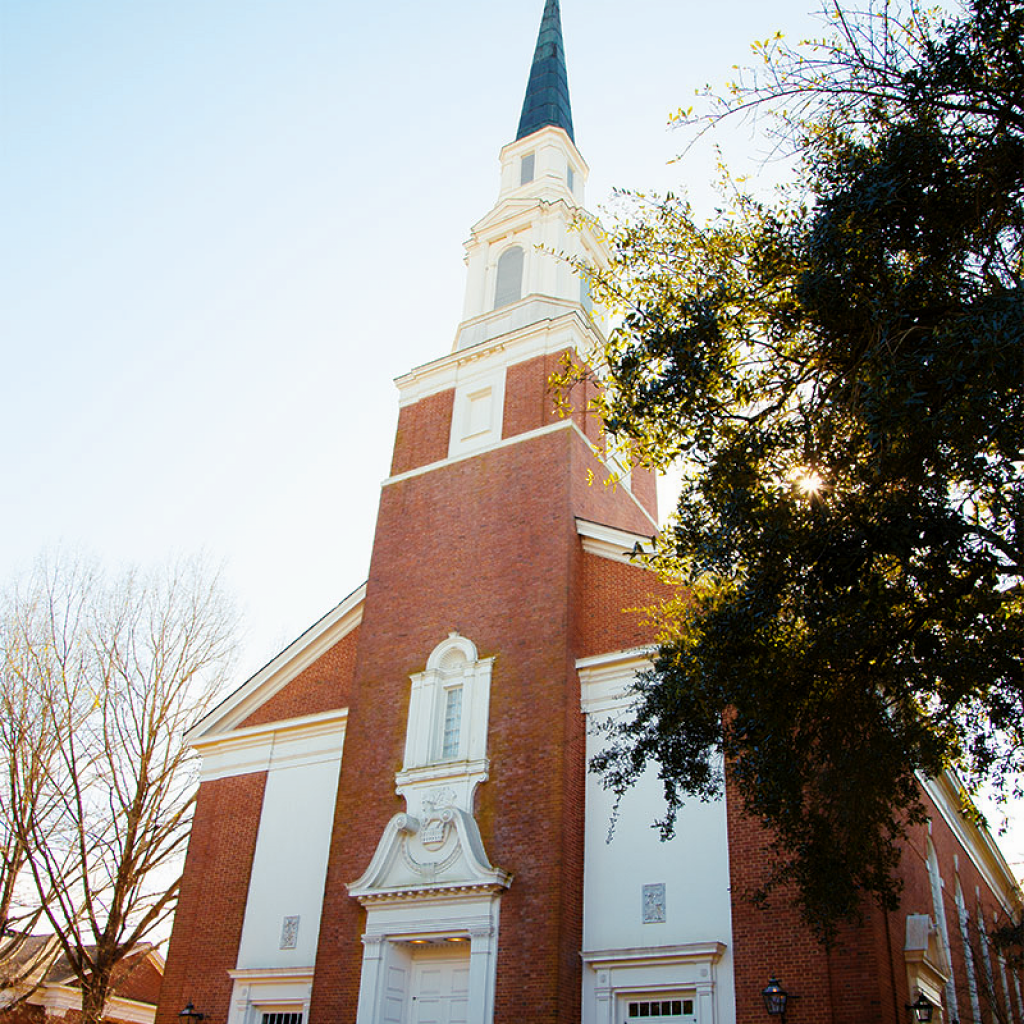Dauphin Way United Methodist Church’s pipe organ is a four-manual and pedal instrument containing 71 ranks of pipes. The pipe organ is designed to fulfill a wide range of musical and liturgical functions. The instrument is not intended to copy any one particular school or period of pipe organ building, but rather to be capable of playing the wide-range of liturgical requirements in worship, and music from all periods and national schools. The tonal specification was drawn up by Michael Quimby in consultation with Colleen Kelsey Hicks, Organist.
The casework, is matched to the classical architecture of the church. In particular, the casework of the Antiphonal division is modeled on the Greek revival cases produced in the middle of the nineteenth century by American organ builders such as the Hook Brothers of Boston. Tonally the instrument is unusual in a number of ways. First, it has four enclosed manual divisions. Secondly, the 32′ and 16′ reed ranks are full-length. There are no “digital” electronic ranks. The instrument contains certain features of the “Symphonic” style of pipe organ, prized in the early twentieth century, which Quimby Pipe Organs has played a leading part in reviving and developing over the last decade. For the first time in a new instrument by Quimby Pipe Organs, the Dauphin Way United Methodist Church pipe organ has revived the use of the Flared Gamba stop similar to those used by the legendary pipe organ builder Ernest M. Skinner. There is a matching Flared Gamba Celeste stop, and indeed the instrument contains a total of five Celeste stops, a feature generally confined to instruments more than double the size. Another significant feature is the chorus reeds of the Trumpet family and orchestral reeds which include the Tuba, French Horn, English Horn, Oboe, and Clarinet voiced by Quimby Pipe Organs Inc. Of special interest are the two contrasting large solo reeds of the Trumpet family, the Tuba and Harmonic Trumpet ranks, voiced on 20″ and 10″ wind pressure and were constructed and voiced in our workshop. Unlike many pipe organs of “Symphonic” design each division of the instrument features a complete Diapason chorus that is designed to be equally versatile with classical, romantic, and symphonic styles of music. A significant feature of the Diapason chorus ranks is the unusually thick metal required to ensure stability of pipe speech, and to achieve the optimum harmonic development. The instrument incorporates 27 ranks from the previous 1956 Reuter pipe organ which have been revoiced and rescaled to function with the new tonal specification. The fine acoustics of the church significantly enhance the voicing in ways that cannot be achieved in a worship space with no acoustical ambience.
The mechanism features Quimby Pipe Organs’ version of the Blackinton slider windchest with pneumatic pallets, allowing the flue pipes of each division to speak to their optimum on common wind channels. There are electro-pneumatic pouch style windchests for all reeds except for the Choir 8′ Clarinet and extended ranks. The four-manual and pedal solid walnut drawknob console, built by Quimby Pipe Organ associates, is in the Aeolian-Skinner style and features the latest in solid-state control systems.
Associates of Quimby Pipe Organs, Inc. who made significant contributions to the construction and installation of this instrument were: Mark Cline, Bart Colliver, Tim Duchon, Chris Emerson, Charles Ford, Rubin Frels, Eric Johnson, Wes Martin, Brad McGuffey, J. O. Love, Joseph Nielsen, Michael Quimby, Janille Rehkop, Brad Richards, Michael Shields, Jim Schmidt, John Speller, Chirt Touch, and Rathana Touch.
ABOUT QUIMBY PIPE ORGANS
Quimby Pipe Organs, Inc., located in Warrensburg, Missouri, has specialized in the building, rebuilding, tuning and servicing of pipe organs for 38 years. The company has a national reputation and examples of their work may be found throughout the United States. The firm additionally maintains a tuning and maintenance service throughout the Midwest and in other locations where QPO has built and rebuilt instruments.
ABOUT THE BUILDER
Michael Quimby, organ builder, is a graduate of the University of Central Missouri (formerly Central Missouri State University), Warrensburg, Missouri, where he received a Bachelor of Music Education degree in 1973, and a Master of Arts degree in music history and literature with applied emphasis in organ in 1975. Mr. Quimby is a member of Pi Kappa Lambda national honor society of music and the American Institute of Organ Builders (AIO), of which he has served as president. Additionally, he has served on the Board of Directors and has also chaired the AIO Ethics Committee. His firm is presently serving a four-year term as President of the Associated Pipe Organ Builders of America. He is a member of the American Guild of Organists, having served as dean of the Greater Kansas City Chapter; the Organ Historical Society; and the International Society of Organ Builders. Mr. Quimby presently serves as organist at First United Methodist Church in Warrensburg, Missouri.
TONAL SPECIFICATION
GREAT ORGAN – Enclosed (Flues 5½” Wind, Reeds 6½” Wind) – 15 Ranks
Open Diapason 16′ 49 pipes (1-12 from Pedal 16′ Open Metal Diapason)
First Diapason 8′ 61 pipes
Second Diapason 8′ 61 pipes
Stopped Flute 8′ 61 pipes
Dulciana 8′ 61 notes from Choir
Octave 4′ 61 pipes
Principal 4′ 61 pipes
Wald Flute 4′ 61 pipes
Twelfth 2 2/3′ 61 pipes
Fifteenth 2′ 61 pipes
Mixture IV 1 1/3′ 244 pipes
Contra Trumpet 16′ 61 notes from Swell
Trumpet 8′ 61 pipes
Clarion 4′ 61 pipes
Tuba 8′ 61 notes from Solo
Harmonic Trumpet 8′ 61 notes from Antiphonal
Flute Tremolo
Antiphonal on Great
Chimes 21 notes
Great to Great 16′
Great Unison Off
Great to Great 4′
SWELL ORGAN – Enclosed (Flues 5½” Wind, Reeds 6½” Wind) – 22 Ranks
Spitzflute 16′ 73 pipes
Diapason 8′ 61 pipes
Chimney Flute 8′ 61 pipes
Spitzflute 8′ 61 notes ext
Gamba 8′ 61 pipes
Gamba Celeste 8′ 61 pipes
Flauto Dolce 8′ 61 pipes
Flute Celeste GG 8′ 54 pipes
Octave 4′ 61 pipes
Hohlflute 4′ 61 pipes
Nazard 2 2/3′ 61 pipes
Flageolet 2′ 61 pipes
Tierce 1 3/5′ 61 pipes
Mixture IV 2 2/3′ 244 pipes
Contra Trumpet 16′ 61 pipes
Contra Oboe 16′ 73 pipes
Trompette 8′ 61 pipes
Oboe 8′ 61 notes ext
Vox Humana 8′ 61 pipes
Clarion 4′ 61 pipes
Tremolo
Swell to Swell 16′
Swell Unison Off
Swell to Swell 4′
Antiphonal on Swell
CHOIR ORGAN – Enclosed (5½” Wind) – 13 Ranks
Contra Dulciana 16′ 73 pipes
Geigen Diapason 8′ 61 pipes
Flauto Traverso 8′ 61 pipes
Gemshorn 8′ 61 pipes
Gemshorn Celeste GG 8′ 54 pipes
Dulciana 8′ 61 notes ext
Unda Maris TC 8′ 49 pipes
Geigen Octave 4′ 61 pipes
Harmonic Flute 4′ 61 pipes
Harmonic Piccolo 2′ 61 pipes
Mixture III 2′ 183 pipes
Clarinet 8′ 61 pipes
Tuba 8′ 61 notes from Solo
Harmonic Trumpet 8′ 61 notes from Antiphonal
French Horn 8′ 61 notes from Solo
English Horn 8′ 61 notes from Solo
Tremolo
Choir to Choir 16′
Choir Unison Off
Choir to Choir 4′
Antiphonal on Choir
Cymbelstern
SOLO ORGAN Enclosed (Flues and English Horn 10″ Wind; Tuba and French Horn 20″ Wind) – 7 Ranks
Flauto Mirabilis 8′ 61 pipes
Flared Gamba 8′ 61 pipes
Flared Gamba Celeste 8′ 61 pipes
Harmonic Flute 4′ 61 pipes
Tuba 8′ 61 pipes
French Horn 8′ 61 pipes
English Horn 8′ 61 pipes
Harmonic Trumpet 8′ 61 notes from Antiphonal
Tremolo
Solo to Solo 16′
Solo Unison Off
Solo to Solo 4′
Chimes 21 notes
PEDAL ORGAN (Flues 5½, 6½, Reed 6½” Wind) – 7 ranks
Contra Bourdon 32′ 32 notes ext (1-5 and 7 Resultant)
Open Metal Diapason 16′ 56 pipes
Bourdon 16′ 51 pipes
Spitzflute 16′ 32 notes from Swell
Contra Dulciana 16′ 32 notes from Choir
Octave 8′ 32 notes ext
Bourdon 8′ 32 notes ext
Spitzflute 8′ 32 notes from Swell
Dulciana 8′ 32 notes from Choir
Super Octave 4′ 32 notes ext
Spitzflute 4′ 32 notes from Swell
Mixture IV 2 2/3′ 124 pipes
Contra Trombone 32′ 32 notes ext
Trombone 16′ 68 pipes
Contra Trumpet 16′ 32 notes from Swell
Contra Oboe 16′ 32 notes from Swell
Tromba 8′ 32 notes ext
Trumpet 8′ 32 notes from Swell
Oboe 8′ 32 notes from Swell
Tromba Clarion 4′ 32 notes ext
Tuba 8′ 32 notes from Solo
Harmonic Trumpet 8′ 32 notes from Antiphonal
ANTIPHONAL ORGAN (Flues 4½”, Reed 10″ Wind) – 7 Ranks
Open Diapason 8′ 61 pipes
Bourdon 8′ 85 pipes
Octave 4′ 61 pipes
Bourdon 4′ 61 notes ext
Fifteenth 2′ 61 notes from Mixture III
Mixture III 2′ 183 pipes
Harmonic Trumpet 8′ 61 pipes
ANTIPHONAL PEDAL
Bourdon 16′ 32 notes from Antiphonal
Bourdon 8′ 32 notes from Antiphonal
RANK ANALYSIS
71 Ranks
COUPLERS
Great to Pedal 8-4′
Swell to Pedal 8-4′
Choir to Pedal 8-4′
Solo to Pedal 8-4′
Antiphonal to Pedal 8′
Swell to Great 16-8-4′
Choir to Great 16-8-4′
Solo to Great 16-8-4′
Choir to Swell 8′
Solo to Swell 16-8-4′
Great to Choir 8′
Swell to Choir 16-8-4′
Solo to Choir 16-8-4′
Pedal to Choir 8′
Great to Solo 8′
Swell to Solo 8′
All Swells to Swell
COMBINATION ACTION Peterson ICS 4000, 256 levels of memory
Great Organ Thumb pistons 1-8
Swell Organ Thumb pistons 1-8
Choir Organ Thumb pistons 1-8
Solo Organ Thumb pistons 1-8
Antiphonal Organ Thumb pistons 1-8
Pedal Organ Thumb pistons 1-8 and toe studs
General Pistons thumb pistons 1-18, 1-6 and 14-18 duplicated by toe studs
Next Piston Piston Sequencer
Previous Piston Piston Sequencer
Set Piston
General Cancel Piston
CRESCENDO AND EXPRESSION PEDALS
General Crescendo Pedal 60 positions, three adjustable and one standard.
Great Expression Pedal
Swell Expression Pedal
Choir/Solo Expression Pedal
REVERSIBLES
Great to Pedal Thumb and toe paddle
Swell to Pedal Thumb and toe paddle
Choir to Pedal Thumb and toe paddle
Solo to Pedal Thumb and toe paddle
Swell to Great Thumb and toe paddle
Choir to Great Thumb
Solo to Great Thumb and toe paddle
Swell to Choir Thumb
32′ Contra Bourdon Thumb and toe paddle
32′ Trombone Thumb and toe paddle
Sforzando Thumb and toe paddle
All Swells to Swell Thumb
Manual Transfer
MIDI
Internal playback sequencer in console



